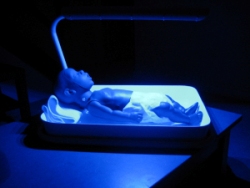May 21 2010
Surrounded by its inventors, a small, rechargeable lamp rested on a table at the front of an MIT classroom auditorium one recent Saturday afternoon, sending a bright beam of light toward the ceiling.
 A device for newborn infants with jaundice delivers phototherapy to treat the condition.
A device for newborn infants with jaundice delivers phototherapy to treat the condition.
The lamp, priced at $20, also can sit on the floor, hang from a peg on a wall, and be carried like a flashlight or worn around the neck. It can withstand drops to the floor and is easily taken apart to be fixed if something goes wrong. Designed to be recharged at a solar generating station, it is strong enough to read by or to light up a room. It holds a charge for eight hours.
Dubbed "Enlight" by its creators—a seven-person team of students from MIT and Rhode Island School of Design—the lamp could eventually be used by millions of people in remote parts of India. The student team will present its prototype to one of India's largest non-governmental organizations, the Energy and Resource Institute, which will consider using Enlight or the concepts behind it in plans to light some 40,000 villages.
"There are 67 million households in India that don't have proper lighting and use open fires or kerosene, which is unhealthy, unsafe, and inadequate," said Lennon Rodgers, an MIT Engineering student and a member of the team that developed Enlight. The product, he said, is "versatile, rugged, low cost, small in size, low in weight, and bright enough to satisfy all their needs."
Rodgers and his teammates unveiled Enlight during the recent final presentations of the Product Design and Development class run by Steven Eppinger, professor of management science and engineering systems at Sloan School of Management. Prof. Warren Seering of MIT's Department of Mechanical Engineering and Matthew Kressy of the Rhode Island School of Design co-teach the course with Eppinger. Most who take the course are either Sloan MBA students, MIT engineering graduate students, or undergraduates in industrial design at RISD.
During the all-day Saturday session, ten student teams demonstrated projects they had been working on for three months. Their assignment had been to design a new product and build a prototype.
The product was to have no more than 10 parts, and there had to be a demonstrable market for it. It also had to relate to one of this year's class themes: green living, global health, and clean transportation. Each team got $1,000 to spend.
The results were dazzlingly clever solutions to simple but often vexing problems. One team designed a collapsible travel coffee cup that can be tucked in a briefcase or backpack, potentially eliminating millions of paper cups in coffee shops. Another team came up with a sleek bicycle helmet that doubles as lock, solving the thorny bike commuter problem of what to do with the bulky helmet at work.
A stackable, reusable, recyclable, easy-to-open, and easy-to-pour plastic cereal box was developed by another team. The box eliminates the need for the inner plastic bag found in cardboard cereal boxes.
Other projects were aimed at improving health. A device for newborn infants with jaundice delivers phototherapy to treat the condition. An infant sleep positioner allows parents to secure and track the side position in which a baby is sleeping. This helps prevent certain skull shape deformities in infant babies.
Eppinger developed the Product Design and Development course over 20 years ago. Similar interdisciplinary courses modeled after it now exist at dozens of universities.
"The course has evolved a lot over 20 years," said Eppinger. "Everything is digital today. The students use the best tools and modern techniques. There are more environmental concerns today."
Some products developed in the class in past years have found commercial success. A student team that came up with a plastic paint can patented the invention, which is used by Sherwin-Williams, Dutch Boy, and Martha Stewart Paints. A device that salts the rim of a margarita glass won a major prize.
But while it's nice when something developed in class gets patented or sold in stores, this is not the point of the class, according to Eppinger. "The goal is to learn the process," he said.
The students have very different areas of expertise, and they learn to work cooperatively. The RISD students know how to design the product, while the MIT engineering students can make it, and the Sloan students can determine how to turn it into a business.
"The teamwork was the most important thing to me," RISD student Anthony Chang said. "I wanted to work with people from different backgrounds. In the real world that's what you do."
Sloan student Stephen Andrew Hale said, "I learned a lot working in a cross-functional team under a tight time pressure."
Several of the teams had corporate sponsors. Nokia supported a team that developed combination search and social networking uses for smart phones. A team that developed a box-like portable computer with a laser keyboard and built-in projector was sponsored by Intel.
A non-profit, Design that Matters, sponsored the team that produced the infant phototherapy device. The organization will explore distributing the device to clinics in Vietnam.
Cambridge-based Design that Matters has sponsored teams in past years and has acquired usable products from the MIT class, according to the company's CEO Tim Prestero. "We want to work with next year's geniuses—before they get accredited," he said.